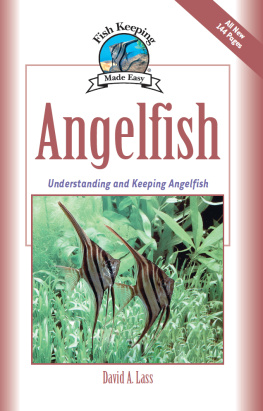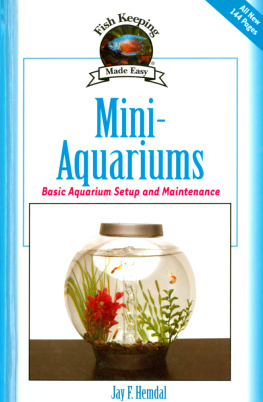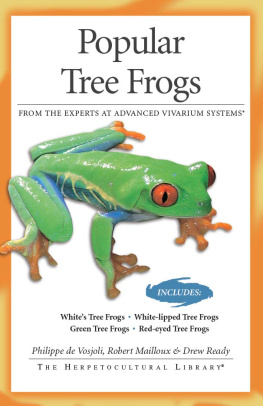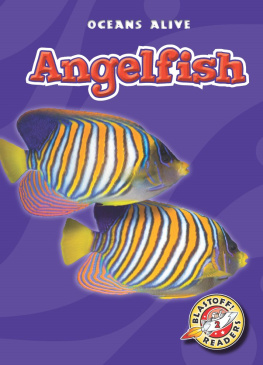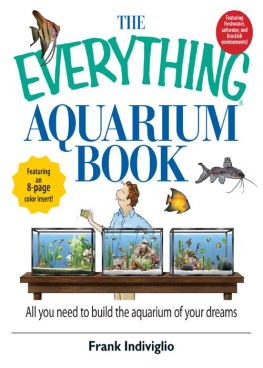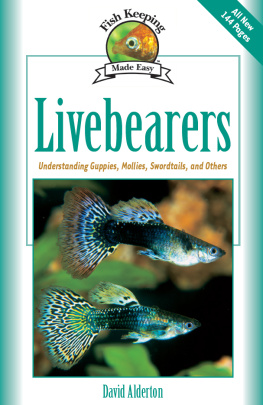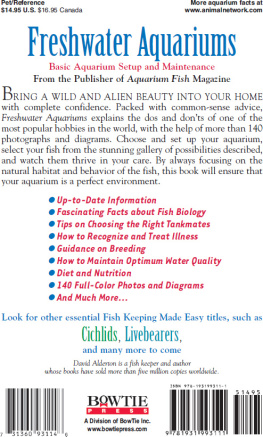

Karla Austin, Director of Operations and Product Development
Nick Clemente, Special Consultant
Barbara Kimmel, Editor in Chief
Patricia Knight, Consulting Editor
Kara Smith, Production Supervisor
Joe Bernier, Designer
Indexed by Melody Englund
Copyright 2008 by I-5 Press
All rights reserved. No part of this book may be reproduced, stored in a retrieval system, or transmitted in any form or by any means, electronic, mechanical, photocopying, recording, or otherwise, without the prior written permission of I-5 Press, except for the inclusion of brief quotations in an acknowledged review.
Library of Congress Cataloging-in-Publication Data
Lass, David A.
Angelfish : understanding and keeping angelfish / by David A. Lass.
p. cm. (Fish keeping made easy)
Includes bibliographical references and index.
ISBN 978-1-933958-22-4
eISBN 978-1-620080-01-6
1. Freshwater angelfishes. I. Title.
SF458.A5L37 2008
639.3774dc22
2007044680
I-5 Press
A Division of I-5 Publishing, LLC
3 Burroughs
Irvine, California 92618
Printed and bound in Singapore
13 12 11 10 09 08 1 2 3 4 5 6 7 8 9 10
Dedication
T his book is dedicated to owners of local fish stores, not only here in the United States but all over the world. For most, theirs is more than a businessit is a labor of love. Unless you have owned, or at least worked in, a local fish store, you cannot know how demanding and difficult the job can be. Certainly, doing it well requires extraordinary commitment to and expert understanding of not only the living beings inside the aquariums but also the living beings who are the customers.
Consider this: a neon tetra is raised in Hong Kong and shipped by air freight to an importer in California, then to the wholesaler, and finally to the local fish store where you buy it for your tank. The price you pay for this very hardy, well-traveled fish is probably less than what you would shell out for a large fancy cup of coffee. What makes your purchase possible are those folks who own and operate local fish stores, devoting much time for uncertain profit. So the next time you shop at yours, give them a nod of thanks: without them, fish selection would be limited, prices would be prohibitively high, and the aquatic hobby would be very boring. Please give them as much of your business as you canwithout them, the hobby would be in real trouble.
Acknowledgments
T he people who have helped me along the long path of my involvement with tropical fish are too numerous to mention, but I must call out one by name, my wonderful wife, Janet Rogalski. Known to my fishy friends as Saint Janet, she has put up with floods, middle-of-the-night trips to my retail stores after a break-inand after a car drove through the side of the buildingdashes to the airport to pick up fish, and more.
We met when I had a large wholesale fish operation in Boston and she was the unlucky customs broker assigned to help me clear a shipment of live marine fish from the Philippines. The airline let me take the shipment the night it arrived, with a promise to complete the necessary customs clearanceat that time U.S. Customs required a special import license to bring live fish into Boston. The next day, the lady customs broker called to ask for that import license number. I told her we had applied for one (a little white lie) but didnt have it yet. She said she would talk to U.S. Customs. That conversation did not go so well: she called back to tell me not to sell any of the fish. I suggested that she inform Customs that the fish had all died. She said she couldnt do that and would get back to me. Her next phone call was to tell me that Customs wanted the common and scientific names of all the fish, which were at that point listed only as product numbers on the invoice. Dutifully, I wrote out all of the names and delivered the list to her office. She then called to complain that she couldnt read my handwriting. I told her that I didnt have a typewriter and was sorry that my handwriting was so bad. She said, Listen, you moron, you dont seem to understand that Customs can close you down. To which I responded, Lets see if we can work this outwhat are you doing for dinner tonight? We met for dinner, and it was love at first sight. We have been happily together ever since. (And I not only found my soul mate; they also let us keep the fish.)
So it is to my dear wife, Janet, that the only specific thank-you goes. To the many others to whom I am grateful, I quote from William T. Inness 1926 preface to the ninth edition of his book Goldfish Varieties and Tropical Aquarium Fishes, the precursor to his classic Exotic Aquarium Fishes: Anyway, we have to accept most of our blessings in life as a matter of course, without credit to the source, satisfied if we may pay the debt to our anonymous benefactors by passing on our own contribution to others. The great man has said everything I would, so I leave it at that.
Contents
The Allure of Angelfish
For me, it all started with angelfish. When I was a kid growing up in Cincinnati, Ohio, in the 1960s, my most prized possession was my copy of the Innes Book (Exotic Aquarium Fishes, by William T. Innes), the bible of generations of tropical fish hobbyists. What mesmerized me and really got me hooked on keeping tropical fish was a color plate tucked into the section on plants.
T he photograph (see page 101) showed a pair of adult angelfish facing each other, fins perfect and erect, surrounded by their babies, exact miniatures of the parents. That picture, and those angelfish, launched the hobby that has been such an important part of my life. Angelfish are still my first love when it comes to fish; I hope that what I have learned over many years of keeping and breeding them will be interesting and useful to you, my fellow hobbyists.
Angelfish are ideal aquarium fish because they are:

This illustration of three angelfish, printed in Beldts Aquarium Catalog in 1931, is a typical example of the catalogs illustrations from the late 1920s through the mid-1940s.
Beautifultheir tall bodies, their long flowing fins, and the way they move gracefully and regally around an aquarium make them extremely attractive fish.
Variedin addition to the wild silver variety, angelfish are available in many different colors and body patterns, with different degrees of flowing veiltail fins.
Hardyangelfish can adapt to water chemistry with wide ranges of pH and hardness, and they will put up with less than perfect tank conditions.
Inexpensivebecause these fish are produced commercially and by hobbyists in large quantities, angelfish are among the more affordable fish available at your local fish store.
Easy to breedvery often two fish will pair off and spawn in a community tank, terrorizing all the other fish because when a pair of angelfish spawn, the territory they like is usually much larger than the tank they and their tankmates are in. Set up in their own tank, a pair will reliably produce offspring for many years.

Next page
